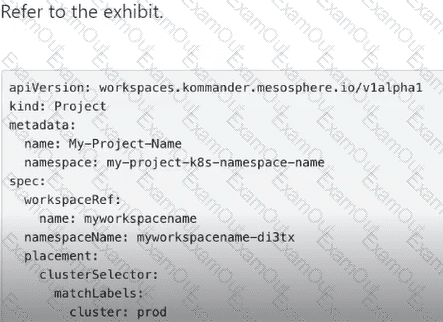
After creating the project, what should the administrator configure in order for the new software releases to automatically deploy to both environments?
After loading the NKP bundles to a private registry in an air-gapped environment, a Platform Engineer now needs the Konvoy bootstrap image to create the bootstrap cluster. The Konvoy image has not been loaded into the registry. Which is the most viable command to load the Konvoy bootstrap image on the bastion host?
A company has different Kubernetes clusters for different business units. Every business unit has separate Kubernetes clusters for production and development because the software deployed in production is different than development. Now, all production clusters for all business units are standardized and all clusters for development are standardized as well.
The company recently acquired NKP Ultimate licenses for all Kubernetes clusters.
How can the company control the standard configuration for both environments in all clusters (production and development)?
A corporate IT team provides Kubernetes clusters for three groups within the company:
Fin VD
Fin Insurance
Fin TravelThe IT group needs to federate policy for all Kubernetes clusters from a single pane of glass, but separate the Kubernetes clusters according to the group that uses them. How should the IT team license and configure their NKP environment to satisfy these requirements?
A company has a new DevOps team that needs to be provided cloud native computing resources. This team will need to have access to multiple NKP clusters for development, testing and validation of an in-house application. However, they also need to be restricted to a specific namespace and a consistent level of access across the clusters within this namespace so that they do not adversely impact the environment of other user groups or the clusters themselves.
As a part of this consideration, the new team also needs to be limited to the amount of storage, CPU and memory they can consume on the clusters. A Platform Engineer has been tasked with providing the appropriate level of access to the team on these multiple NKP clusters.
How should the engineer best accomplish this task?
During a deployment of NKP, a Platform Engineer received an error indicating an issue with the bootstrap. While troubleshooting with support, the engineer noticed that the KUBECONFIG file was missing. How would the engineer recreate the bootstrap cluster and create a context file named bootstrap-cluster.conf?
A company has decided to expand NKP to features that require higher product tiers, like fleet-management and additional infrastructure providers. The company has already obtained the necessary licensing. Which action is required when adding and activating a license from NKP Starter to a higher-tier product?
A Cloud Engineer wishes to attach existing AKS clusters to a newly deployed NKP management cluster.
What should the engineer consider specific to attaching these types of clusters to NKP?
A Platform Engineer needs to utilize the Konvoy Image Builder for building a custom operating system image. This image will be used to deploy clusters on various platforms. The engineer has been tasked with creating an OS image compatible with Konvoy’s requirements. In order to successfully build a compatible image using the Konvoy Image Builder, the engineer needs to ensure that a development environment meets the necessary prerequisites.
Which system is required to create a compatible OS image with the Konvoy Image Builder?
A company has enabled auto-scaling within an NKP cluster. What is the behavior for auto-scaling?

